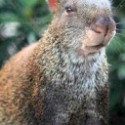Explore Articles Filed Under: Indigenous Culture

Chewing the leaves of the coca plant (Erythroxylum coca) plays a significant role in traditional Andean culture. Coca acts as a stimulant to overcome fatigue, hunger, and thirst. It is considered particularly effective against altitude sickness. It also is used as an anaesthetic to alleviate the pain of headache, rheumatism, wounds and sores. Coca leaf chewing is most common among indigenous communities across the central Andean region, particularly in the highlands of Colombia, Ecuador, Bolivia, and Peru, where the cultivation and consumption of coca is part of the national culture, and where sharing coca leaves is a powerful symbol of social and cultural solidarity.

Small game is a staple in the diet of both mestizo and indigenous peoples in the Upper Amazon. Small game is generally gutted but not skinned. Once I was helping my jungle survival instructor, Gerineldo Moises Chavez, field dress an agouti — essentially a large rat. “In North America,” I said, “we generally take off the head.” He looked at me as if I was crazy. “Lots of good things in the head,” he said.

A virote was originally a crossbow bolt, brought to South America by the conquistadores. The Spanish term was then applied to the darts shot by the Indians with a blowgun. These darts were made primarily from two sources — from the spines of any of the spiny Bactris or Astrocaryum palms or from any of several Euterpe palms, whose very hard wood is used to make both bows and arrows. My jungle survival instructor, Gerineldo Moises Chavez, could whittle a usable dart from the wood of a Euterpe palm with his machete in less than a minute.
There have been relatively few investigators who have studied the healing practices of the mestizos in the Upper Amazon. All of them — anthropologist Luis Eduardo Luna, medical anthropologist Marlene Dobkin de Ríos, and Jacques Chevalier, an expert in social anthropology and political economy — have characterized the healers they worked with as shamans. And, indeed, my teachers don Roberto Acho and doña María Tuesta have been perfectly comfortable being called — and calling themselves — chamánes. This differs markedly from the attitude of many indigenous peoples in North America, who object strongly to having their traditional healers called shamans, as a term imposed from outside by the dominant culture.

In 1955, banker R. Gordon Wasson, an amateur connoisseur of mushrooms, was introduced by the Mazatec shaman María Sabina to the ancient teonanácatl — the Psilocybe mushroom, called ‘nti-ši-tho in Mazatec, Little-One-Who-Springs-Forth. María Sabina called them her saint children. Wasson was deeply impressed by his mushroom experience. He speaks of ecstasy, the flight of the soul from the body, entering other planes of existence, floating into the Divine Presence, awe and reverence, gentleness and love, the presence of the ineffable, the presence of the Ultimate, extinction in the divine radiance. He writes that the mushroom freed his soul to soar with the speed of thought through time and space. The mushroom, he says, allowed him to know God.

Of central importance in ribereño life is the chacra, the swidden or slash-and-burn garden. This is true also of many Amazonian peoples, for whom gardens — and garden magic — are a central feature of the domestic economy. A chacra is made by clearing an area of forest, burning the felled trees and other vegetation, clearing the movable remaining vegetation and reburning it, and then planting yuca, manioc, cassava (Manihot esculenta), plátano, plantain (Musa paradisiaca), and other cultivated plants and trees such as beans, palms, pineapples, papaya, and mango.

In the ongoing debates about the relationship between indigenous peoples and outsiders — that is, largely white, urban, relatively wealthy, and spiritually eclectic outsiders — who seek access to indigenous ceremonies and spiritual practices, the question is frequently posed as to who may legitimately represent an indigenous tradition to the outside world.

I had promised myself that I would not talk about canaima. Now, I have been a lot of places in my time, and I have seen some very weird things. But there are really only two things that I find truly creepy — tsantsa, shrunken human heads, and canaima. And that is because, I suppose, both tsantsa and canaima are supposed to be creepy. That is their purpose — to create horror and fear.

The first seventy years of Soviet power, writes historian Philip Walters, “saw a sustained offensive against religion on a scale unprecedented in history.” Shamanism — sometimes called black faith — was a particular target; shamans in Siberia were subject to public denunciation, confiscation of their property, and imprisonment. Their drums were impounded, and they were branded kulaks, class enemies — not a frivolous charge, since many shamans were in fact centers of anti-Soviet resistance.

Khadak — the term is a Mongolian loan word from Tibetan meaning ceremonial scarf — is a film directed by Peter Brosens and Jessica Woodworth. Brosens had already made three documentaries about Mongolia when he and Woodworth filmed Khadak, which began as a documentary about commercial aviation, and then transformed itself into a piece of magical realism about Mongolian shamanism. “Motivating the film are not only the complex economic and political manifestations of change,” the directors say, “but also the more evasive and intangible spiritual ones.”

Discussing the article:
Hallucinogens in Africa